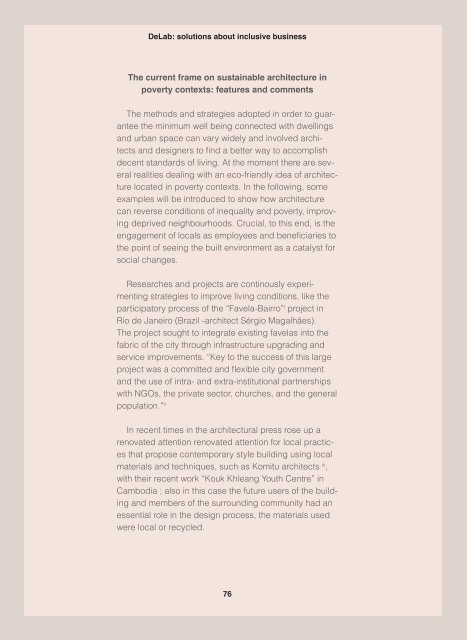INCLUSIVE BUSINESS
Create successful ePaper yourself
Turn your PDF publications into a flip-book with our unique Google optimized e-Paper software.
DeLab: solutions about inclusive business<br />
The current frame on sustainable architecture in<br />
poverty contexts: features and comments<br />
The methods and strategies adopted in order to guarantee<br />
the minimum well being connected with dwellings<br />
and urban space can vary widely and involved architects<br />
and designers to find a better way to accomplish<br />
decent standards of living. At the moment there are several<br />
realities dealing with an eco-friendly idea of architecture<br />
located in poverty contexts. In the following, some<br />
examples will be introduced to show how architecture<br />
can reverse conditions of inequality and poverty, improving<br />
deprived neighbourhoods. Crucial, to this end, is the<br />
engagement of locals as employees and beneficiaries to<br />
the point of seeing the built environment as a catalyst for<br />
social changes.<br />
Researches and projects are continously experimenting<br />
strategies to improve living conditions, like the<br />
participatory process of the “Favela-Bairro” i project in<br />
Rio de Janeiro (Brazil -architect Sérgio Magalhães).<br />
The project sought to integrate existing favelas into the<br />
fabric of the city through infrastructure upgrading and<br />
service improvements. “Key to the success of this large<br />
project was a committed and flexible city government<br />
and the use of intra- and extra-institutional partnerships<br />
with NGOs, the private sector, churches, and the general<br />
population.” ii<br />
In recent times in the architectural press rose up a<br />
renovated attention renovated attention for local practices<br />
that propose contemporary style building using local<br />
materials and techniques, such as Komitu architects iii ,<br />
with their recent work “Kouk Khleang Youth Centre” in<br />
Cambodia ; also in this case the future users of the building<br />
and members of the surrounding community had an<br />
essential role in the design process, the materials used<br />
were local or recycled.<br />
76


